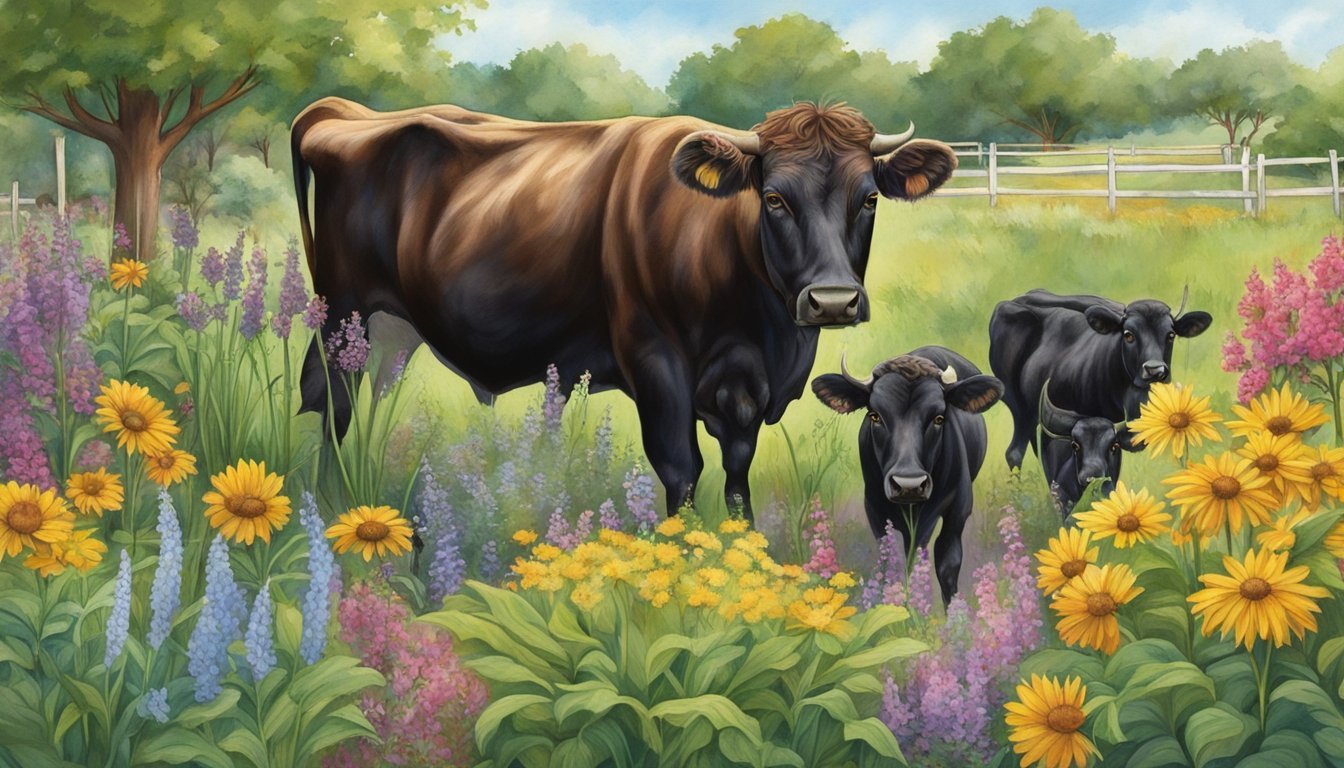Dexter Cattle and Companion Planting
Strategies for a Sustainable Homestead Ecosystem
Dexter cattle offer valuable opportunities for those seeking to establish a sustainable and productive homestead ecosystem. Originating from Ireland, these robust cattle are renowned for their adaptability and efficiency, thriving in various climates and making them an attractive option for small-scale farmers. Their small stature renders them less intimidating and more manageable than larger breeds, and their ability to prosper on pasture-based diets or with grain supplementation enhances their appeal to homesteaders aiming for self-sufficiency and ecological balance.
Companion planting is a key element in creating a thriving homestead ecosystem, working in tandem with livestock like Dexter cattle. This agricultural practice involves growing different plants together for mutual benefit, such as pest control, pollination, habitat provision for beneficial creatures, and improved growth and flavor. For example, planting certain herbs and flowers deter pests, reducing the need for chemical interventions and contributing to a healthier environment for both crops and livestock. The strategic design of companion planting can lead to a more productive and sustainable system, enriching soil fertility, and increasing biodiversity on the homestead.
Together, Dexter cattle and companion planting represent a comprehensive approach to permaculture, where each component of the ecosystem supports another. The integration of these practices brings homesteaders closer to achieving a self-reliant and environmentally responsible way of life. Dexter cattle contribute to the cycle of nutrients through their manure, which enriches the soil for plants, while companion planting creates a balanced environment that can reduce the workload of the farmer and the ecological footprint of the homestead. This symbiosis exemplifies a holistic method of farming that cultivates resilience and productivity.
Understanding Dexter Cattle
Dexter cattle are renowned for their versatility and suitability for sustainable homesteading. Their compact size and good nature make them ideal for small farms and various climates.
History and Origin
Dexter cattle hail from Ireland, where they were developed in the early 1800s. Bred by small landholders, they were selected for both milk and meat production.
Physical Characteristics
Dexters are small cattle with a broad body, well-rounded hindquarters, and either short or long legs. Their color varies predominantly between black, red, and dun. Originally horned, many are now polled due to selective breeding.
Behavior Traits and Temperament
These cattle are known for their gentle and friendly disposition, making them easy to handle even for novice farmers.
Dexter Cattle as Livestock
Dexters are considered thrifty animals, requiring less pasture space and being efficient grazers.
Health and Maintenance
Known for their hardiness, Dexter cattle require relatively low maintenance. Awareness of health issues common in small breeds is essential.
Breeding Dexter Cattle
Dexters are valued for their high fertility and ease of breeding. Cows are known for calving without difficulties, producing vigorous offspring.
Dexter Cattle for Meat Production
Dexter beef is prized for its quality, tender texture, and excellent marbling. They are capable of producing up to 400 pounds of meat.
Dexter Cattle for Dairy Production
Their rich milk, high in butterfat, is suitable for cheese production. They can produce several gallons of milk daily.
Advantages of Small Size
The manageable size of Dexter cattle means they require less space and are easier to handle.
Dexter Cattle in Diverse Climates
Dexters are hardy animals, adapatable to a range of weather extremes and able to thrive in diverse climates.
Economic Considerations
For those investing in livestock, Dexters provide a cost-effective option with reduced infrastructure and maintenance costs.
Dexter Cattle for Sustainable Farming
They are considered dual-purpose, contributing to the sustainability of a homestead.
Associations and Resources
The American Dexter Cattle Association and other organizations provide support and resources for breeders and owners.
The Role of Dexter Cattle in Biodiversity
As a rare breed, Dexter cattle play a part in the conservation of livestock biodiversity.
Dexter Cattle and Legal Considerations
Understanding livestock laws and registration standards is important for keeping Dexter cattle.
Companion Planting Basics
Introducing plants that benefit the animals and the ecosystem is the core of companion planting.
Benefits of Companion Planting
The practice promotes biodiversity, efficient nutrient management, and ecosystem benefits.
Choosing Companion Plants for Dexter Cattle
Select plants that provide good forage and meet the nutritional needs of the cattle, while also maintaining soil health.
Integrating Livestock with Plant Systems
Proper integration leads to a symbiotic relationship where both livestock and plants thrive.
Companion Planting for Soil Health
Diverse planting near grazing areas can enhance soil health and structure.
Companion Planting for Pest Control
Plants can serve as natural deterrents for pests, reducing the need for chemical intervention.
Companion Planting for Forage
Good forage plants can supplement the cattle's diet and reduce feed costs.
Challenges in Companion Planting
There are challenges to companion planting, like finding the right balance between plant and animal needs.
Plant Diversity and Livestock Welfare
Diverse diets from a range of plants can lead to better livestock health and welfare.
Economic Benefits of Companion Planting
Companion planting can lead to financial savings and increased productivity.
Companion Planting and Climate Resilience
The approach helps in creating a system resistant to climate change and weather extremes.
Involvement of Community in Homesteading
Community support and networking can be crucial in the success of a homesteading project.
Creating a Thriving Homestead Ecosystem
By integrating Dexter cattle with the right companion plants, homesteaders can build a sustainable and thriving ecosystem.



